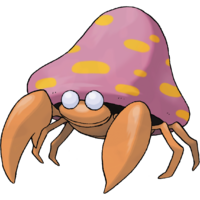Parasect (Pokémon): Difference between revisions
m (Added Diamond dex entry.) |
mNo edit summary |
||
| Line 15: | Line 15: | ||
species=Mushroom | | species=Mushroom | | ||
height-ftin=3'3" | | height-ftin=3'3" | | ||
height-m=1 | | height-m=1.0 | | ||
weight-lbs=65 | | weight-lbs=65 | | ||
weight-kg=29.5 | | weight-kg=29.5 | | ||
| Line 24: | Line 24: | ||
egggroup1=Bug | | egggroup1=Bug | | ||
egggroup2=Plant | | egggroup2=Plant | | ||
hatchsteps=5120 | | |||
effortyield=2 Atk, 1 Def | | effortyield=2 Atk, 1 Def | | ||
expyield=128 | | expyield=128 | | ||
Revision as of 10:45, 30 June 2007
|
|
|
| ||||||||||||||
| ||||||||||||||
|
| |||||||||||||
|
| |||||||||||||
| ||||||||||||||
| ||||||||||||||
| ||||||||||||||
|
| |||||||||||||
|
| |||||||||||||
| ||||||||||||||
| ||||||||||||||
| ||||||||||||||
| ||||||||||||||
Parasect (Japanese: パラセクト Parasect) is a Bug/Grass-type Pokémon.
Biology
Physiology
Gender differences
None.
Special abilities
Behavior
Habitat
Parasect can often be found in caves, since sunlight and dry air hurt their skin. They can also thrive in dank forests with lots of humidity where conditions are ideal for fungi.
Diet
Main article: Pokémon food
In the anime
Cassandra uses a Paras which evolves in EP044.
Officer Jenny uses a Parasect in AG065.
Game data
Pokédex entries
| ||||||||||||||
| ||||||||||||||
| ||||||||||||||
| ||||||||||||||
| ||||||||||||||
| ||||||||||||||
Game locations
| |||||||||||||||||||||||||||||
| |||||||||||||||||||||||||||||
| |||||||||||||||||||||||||||||
| |||||||||||||||||||||||||||||
| |||||||||||||||||||||||||||||
| |||||||||||||||||||||||||||||
In side games
| Game | Location |
|---|---|
| Pokémon Trozei | Endless Level 53 Endless Level 63 Forever Level 3 Mr. Who's Den |
| Pokémon Mystery Dungeon | Evolve from Paras |
| Pokémon Ranger | Krokka Tunnel |
Base stats
| Stat | Range | ||
|---|---|---|---|
| At Lv. 50 | At Lv. 100 | ||
HP: 60
|
120 - 167 | 230 - 324 | |
95
|
90 - 161 | 175 - 317 | |
80
|
76 - 145 | 148 - 284 | |
60
|
58 - 123 | 112 - 240 | |
80
|
76 - 145 | 148 - 284 | |
30
|
31 - 90 | 58 - 174 | |
Total: 405
|
Other Pokémon with this total | ||
Of the first generation Bug Pokémon, Parasect ties with Butterfree, Beedrill and Scyther for the highest base SpDef.
Type effectiveness
Template:DP type effectiveness
In Generation I, the effectiveness of Poison-type moves is 400.
If Parasect has the ability Dry Skin, the effect of Water becomes 0, and Water attacks will heal 25% of Parasect's HP. In addition, the effect of Fire becomes 800.
Learnset
Template:Evolved learnset intro
By leveling up
| Game | Generation I | Generation II | Generation III | Generation IV |
|---|---|---|---|---|
| 27 | Spore | |||
| 28 | Spore | |||
| 30 | Spore | Growth | ||
| 35 | Slash | |||
| 37 | Slash | |||
| 39 | Slash | Giga Drain | ||
| 43 | Growth | |||
| 46 | Growth | |||
| 47 | Aromatherapy | |||
| 48 | Growth | |||
| 51 | Giga Drain | |||
| 53 | Giga Drain | |||
| 55 | X-Scissor | |||
| 59 | Aromatherapy |
By TM/HM
Side game data
Evolution
Trivia
Origin
There are many forms of fungus that grow on insects, any one of which could have inspired Parasect's design, like the entomophthora muscae, which grows on the back of the common housefly.
Name origin
Parasect's name is a combination of parasite and insect, referring to the parasitic mushroom on this insect's back.
In other languages
External links
|
|
|

|
This Pokémon article is part of Project Pokédex, a Bulbapedia project that aims to write comprehensive articles on each Pokémon species, as well as Pokémon groups and forms. |
- Pokémon pages lacking disambiguation notices
- Pokémon in the Medium Fast experience group
- Pokémon in the Kanto Pokédex
- Pokémon in the Johto Pokédex
- Body style ? Pokémon
- Generation I Pokémon
- Bug-type Pokémon
- Grass-type Pokémon
- Dual-type Pokémon
- Pokémon without Hidden Abilities
- Red-colored Pokémon
- Body style Unknown Pokémon
- Gender-unknown Pokémon
- Bug group Pokémon
- Plant group Pokémon
- Pokémon with a base stat total of 405
- Pokémon whose Special stat became their Special Defense
- Pokémon that are part of a two-stage evolutionary line

